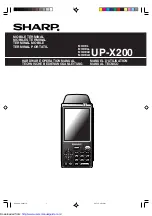
The NED ASCII Text Editor
69
E-EQ-MX1ISRG-F
MX1 I-Safe Reference Guide
The NED ASCII Text Editor
NED uses the standard Windows interface for cut, copy, and paste operations. Del and Shift+Del
both move the selected block to the clipboard. There is no true undo command, but Ctrl+V or
Shift+Ins may be used to paste the clipboard contents to the current cursor position. The next
section lists all the default shortcut keys.
The NED editor is a menu-based text editor available for use with ROM-DOS. This editor is
similar to other desktop editors but has special functions designed for use in editing C-source and
assembly code.
To start the editor, enter
NED [filename] [filename]
NED may be initiated with or without filename arguments. Wildcard file specifications are
allowed.
Up to ten files can be entered on the command line. If NED is run without arguments, it loads all
files accessed during the last editing session, returning you to the exact position in the file. You
can switch between the open files.
You can also enter
NED @errfile
where
errfile
is the name of your compiler error output file. NED loads all files that had errors and
allows you to move between errors.
Once NED is running, you may load files into memory by using the File/Open menu command.
File/Reload replaces the current file with a new file or reloads a new copy of the same file.
File/Reload confirms before replacing an unsaved file.
•
If a search string is all lowercase, NED treats it as a case-insensitive search. If a search string
contains any uppercase letters, it is case sensitive. The replacement string is inserted exactly
as entered. Repeating a Search command repeats the last Forward or Backward Search
operation, not the last Replace operation.
•
There is one bookmark for all files. Once the bookmark is set, going to the bookmark returns
you to the file and position where you set it.
•
The Indent and Remove-indent (referred to as Undent in the Options/Do Command)
commands work on tabs. Indent inserts a tab at the beginning of the current line, or if a block
is active, at the beginning of each line in the block. Remove-indent removes the first tab from
the current line or from each line in the block. If there are no tabs, Remove-indent has no
effect.
•
Toggle case inverts the case of the current character if no block is active. If a block is active,
Toggle case sets the entire block to uppercase if the first character was lower and to
lowercase if the first character was uppercase.
•
Tabs are currently set to 3 for .C, .H, .CPP, .HPP, and .T files. They are set to 8 for all other
files.
•
File/Print prints the current block if there is one, otherwise it prints the current file. NED
prompts for a device to print to, which may be a filename. Tabs are expanded to spaces.
•
The Options/Do Command is intended primarily for debugging. This command allows you to
execute any editor command by choosing it from a menu list.
•
The macro commands (Record Macro/Play Macro) allow you to define a sequence of
Summary of Contents for MX1-IS
Page 38: ...28 Miscellaneous Connectors MX1 I Safe Reference Guide E EQ MX1ISRG F...
Page 42: ...32 Handling Batteries Safely MX1 I Safe Reference Guide E EQ MX1ISRG F...
Page 124: ...114 Numeric Alpha Key Map 41 Key MX1 I Safe Reference Guide E EQ MX1ISRG F...
Page 156: ...146 ROM DOS 6 22 Command Summary MX1 I Safe Reference Guide E EQ MX1ISRG F...
Page 164: ...154 Index MX1 I Safe Reference Guide E EQ MX1ISRG F...








































